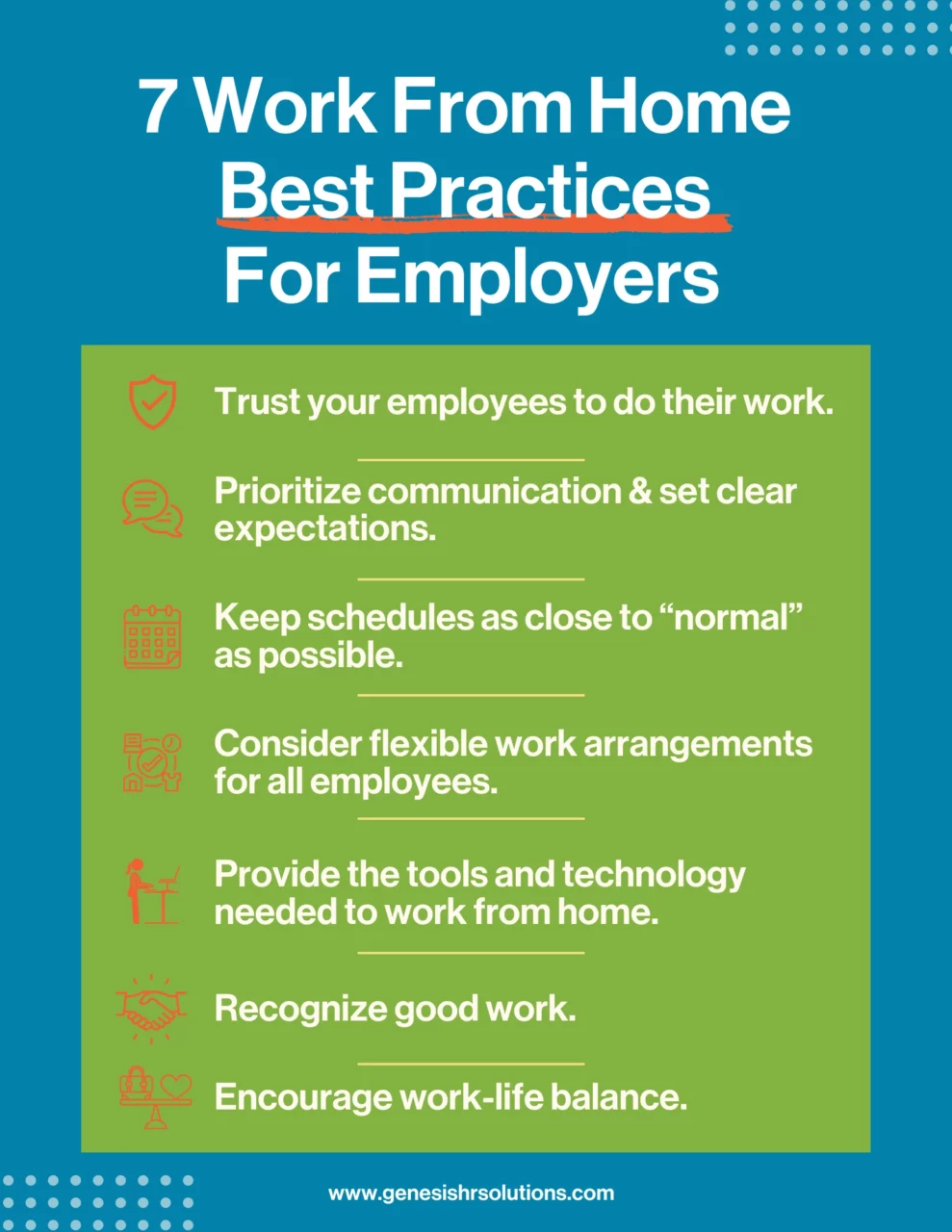Whether you’re an employer already familiar with managing a work-from-home workforce or your company is just diving into the waters of working remotely, the need to consider work from home best practices has never been more apparent. Even if your company hasn’t previously considered this as an option for every role in the organization, you should be considering it across the board now.
Naturally, working from home has its challenges and complications. As a company that works daily with a variety of organizations with remote work policies, we are uniquely qualified to help address this issue. In this article, I’ve identified seven work from home best practices that you as an employer can implement within your company to ensure working from home is productive and successful.
Need to create a work-from-home policy but don’t know where to start?Get a sample policy—plus two free templates to help you streamline your work-from-home proposals and agreements—in this free guide.
7 Work From Home Best Practices For Employers

1. Trust your employees to do their work.
The bedrock of successful remote work is trust; as an employer, this must be your mindset first and foremost. If you can’t trust your employees to work from home, attempting this style of work will not be successful.
The bedrock of successful remote work is trust; as an employer, this must be your mindset first and foremost. Share on XPandemic Work From Home vs. Normal Work From Home
It’s important for managers to remember that working from home during a time of crisis isn’t standard fare. Right now, employers must recognize that working from home is more like surviving working from home for many people. They may have multiple household members working alongside them, space challenges, children at home, and more.
Although this article is written to be all-encompassing, I’d be remiss not to say something here about the realities of working from home in emergency situations. All the best practices listed here can and should be modified to fit your company in abnormal times, and then reassessed when things return to normal.
2. Prioritize communication & set clear expectations.
Another working from home tip: Success depends on your ability to communicate clearly and consistently with employees. To ensure tasks are accomplished and goals are met, implement the following communication practices:
- Keep scheduled team meetings and one-to-one appointments on the calendar if you do them in person. If not, set up periodic check-ins to identify if employees need help, if projects need to move, etc.
- Use tools like Slack, GoToMeeting, and Zoom for video conferencing.
- Make sure your supervisors, managers, and leaders are readily available so they can connect with employees.
- Keep calendars up to date and easily accessible for everyone on the team.
- Use messaging tools internally to keep in touch, and encourage the use of settings like “Available” and “Away” to give visibility into whether or not employees are available to communicate.
- Limit the number of emails sent, as employees are likely overwhelmed by inboxes overflowing with content of varying importance.
3. Keep schedules as close to “normal” as possible.
Communicate to employees your expectations about their working hours, and then listen to their responses about what they can or can’t do in terms of their schedules. I suggest keeping working hours as close to normal as possible to make it easy for everyone to stay in touch. Employers should be willing to listen and be flexible for their employees, and employees should be willing to communicate their schedules and availability (and even over communicate) to their supervisors and managers.
If possible, employees should be permitted to work outside of normal hours. This change should be clearly communicated to managers and team members.
Allow employees to use PTO to offset the times they’re not available. (Note: The federal government has expanded medical leave since April 2, 2020, allowing employees to use up to 80 hours of sick time to care for quarantined individuals or children without daycare.)
Finally, employers should understand that this is not a normal time, and many of their employees are also acting simultaneously as caregivers and teachers in addition to their roles as employees. Especially in times of crisis, some degree of flexibility is required from both sides. However, it’s important to understand that schedules are crucial for effective communication when working from home.
4. Consider flexible work arrangements for all employees.
To keep everyone working, be creative about ways to accommodate employees who typically haven’t been able to work from home—like receptionists, greeters, call center employees, etc. If these types of jobs were performed from a desk in the office, they likely can be performed from home with a little creativity. For example, equipped with the right tools, receptionists can still answer phones and redirect callers to the appropriate people within your office. They can also arrange virtual meetings, organize schedules, and more—all from home.
5. Provide the tools and technology needed to work from home.
One best practice we recommend to our clients is to provide team members with company tools—laptops, servers, databases—they need to accomplish their jobs. One bonus to providing tools (rather than having employees use their own) is that employers have more control over what’s being done on machines that belong to the company. Your company’s IT department can also install additional layers of security for any tools you provide and monitor their usage.
6. Recognize good work.
Working from home can be isolating, even when there is not a crisis to contend with. This makes validation from employers even more important. Managers should allocate one or two days each week to recognize and acknowledge individual employee contributions and successes. If you don’t have regular one-on-one meetings or company meetings, now is the time to implement them. In addition to providing status updates and sharing progress toward goals, a portion of meetings should be dedicated to recognizing the good work of your team. Recognition doesn’t have to cost a thing, but it can provide a much-needed morale boost that encourages employees to work harder and gives them incentive to stay at your company.
7. Encourage work-life balance.
Finally, set limits on how much your employees work while they’re at home. For some employees, it will be difficult to stop working if they cannot physically remove themselves from their workspaces. As a supervisor, it is up to you not only to make sure work is being done, but to keep an eye out for employees who are doing too much work—to the detriment of their personal lives, productivity, and health.
Status updates and progress checks are the best time to review and address this issue. Just as you would discuss any lack of progress being made, you should discuss if time spent “at work” is overwhelming your people, and help them establish healthy boundaries.
Is your team working from home? What are your tips for success?
Leave a comment below about your organization’s best practices for working remotely; we’d love to add them to a future article.
And if you have questions about HR issues related to working from home, ask us! Contact us today, and we’ll be glad to help you navigate through the COVID-19 crisis—and into the future.





